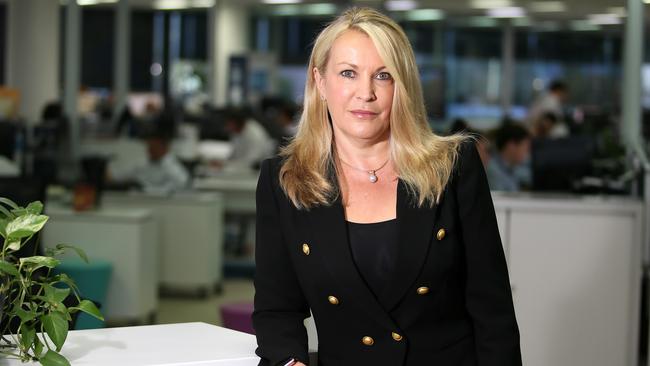2019 CEO Survey: Elizabeth Gaines, Fortescue Metals
Australian mining’s autonomous vehicles are cutting costs and attracting global attention, says Fortescue’s Elizabeth Gaines.

Every year The Australian’s John Durie asks some of the biggest names in Australian business five key questions about what’s coming in the year ahead.
Here, in her own words, is what Fortescue Metals Group’s Elizabeth Gaines sees ahead in 2020.
You can read more from the CEO Survey across this summer.
How is your company affected by low-interest rates and what is needed to boost the economy?
Fortescue takes a long-term view when considering investment opportunities given the scale and nature of major mining investments. We take into account a range of factors, including the current interest rate environment. Additionally, consistency in legislation is a key factor in increasing investor confidence when it comes to making long-term investment decisions.
In the past 18 months, Fortescue has announced a total investment of $US3.875bn in two projects in Western Australia, the Eliwana Mine and Rail Project and the Iron Bridge Magnetite Project which together will create up to 5000 jobs during construction and 1500 full-time site positions once operational.
Contrary to slower investment rates for the Australian economy, the WA resources sector is investing in growth with an estimated $108bn worth of resource projects in the pipeline as of September 2019. Ensuring the settings are in place to provide confidence in approving these projects will provide further stimulus to the economy.
What is the impact of government regulations on your company, including those applying to the financial sector?
Australia has the most innovative resources industry in the world, and it’s up to all of us to ensure that our mining sector remains a global leader. The recent announcements to streamline project approvals are welcomed, and a continued focus on reducing red tape and incentivising innovation will be very important in ensuring Australia is at the forefront of advancements in technology and skills to ensure these projects proceed.
What percentage of company revenues are spent on research and development, and how is your company using technology to improve performance?
Fortescue has a proud history of partnering with suppliers in researching and developing technologies that deliver productivity and efficiency improvements.
Our cost journey is nothing short of remarkable and innovation has played a significant role. In FY12, our C1 cost was $US48 a wet metric tonne reducing by 73 per cent to $US13/wmt in FY19. Our implementation of autonomous haulage has been integral to this cost reduction, delivering productivity improvements of 30 per cent compared to the manned fleet as well as significant safety benefits. The advances we have pioneered in automation are now receiving global recognition. Even the space industry is now looking towards Australia’s mining sector to help deliver the next advancements in space exploration, including the United States’ planned expedition to the moon and ultimately Mars. We have a strong focus on advancements in energy technology to support our goal of decarbonisation, as evidenced by our landmark agreement with the CSIRO for hydrogen technology. Notwithstanding our efforts, there is an opportunity for government policy to support research and development across a range of areas, including energy developments.
What are the three major policy issues facing the country and what should be done about them?
● China: The strength of Australia’s resources sector and its significant contribution to the Australian economy is directly related to our relationship with China. As we look towards 2020, we must retain a strong narrative about the importance of this key trading relationship. Fortescue’s engagement with China extends beyond our deep relationships with our iron ore customers through to procurement, financing arrangements, as well as academic, policy and social linkages. Through this multifaceted approach, Fortescue has forged strong relationships with businesses and government in China that have significantly contributed to our success and Australia’s economic prosperity. It is crucial that we encourage further engagement and appreciation of the breadth and depth of this $208bn bilateral trade relationship, to support the growth of our national economy and in turn create jobs and economic investment opportunities, especially in Western Australia.
● Climate change: Access to reliable, secure and competitive energy is an important consideration for the mining sector in Western Australia, and a clear and consistent national climate change and energy policy is crucial to ensuring Australia can capitalise on the opportunities renewable energy presents. As a significant consumer of energy, we continue to identify opportunities to introduce renewable energy into our energy supply, such as solar and hydrogen and we’re focused on implementing innovative and practical initiatives to reduce emissions and manage climate-related risks as evidenced by our recently announced Chichester Solar Gas Hybrid Project.
● C-Suite Diversity: Female participation on ASX boards and C-Suites is stalling and, on current trajectories, we will not see equal representation of women in CEO roles until the turn of the century. The gender pay gap position has not improved. At Fortescue, we are proud that half of our board of directors are women and 26 per cent of senior managers are female, underpinning our commitment to build a pipeline of talent for women into C-suite positions. We are focused on implementing practical policies that support women in the workplace to ensure that number continues to grow.
What are the major impediments to long term growth facing your company and what can or is being done about them?
The Federal Treasurer recently spoke about the need for corporate Australia to invest in growth versus paying dividends. From Fortescue’s point of view, we are doing both: we’re investing for growth, we’re investing for the future, and our dividend policy to pay out between 50 to 80 per cent of net profit after tax ensures that at the same time, we’re delivering strong returns to our shareholders.




To join the conversation, please log in. Don't have an account? Register
Join the conversation, you are commenting as Logout